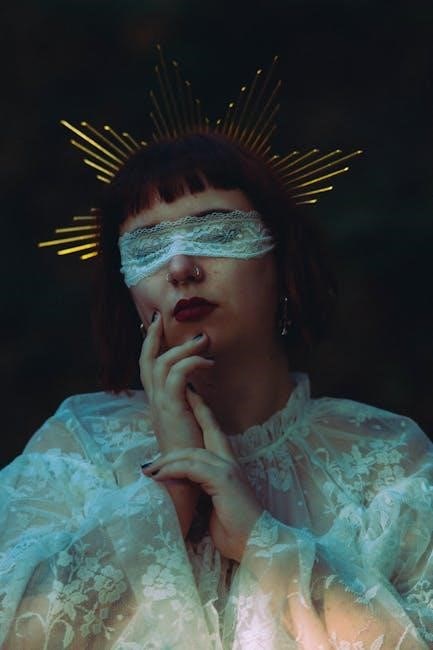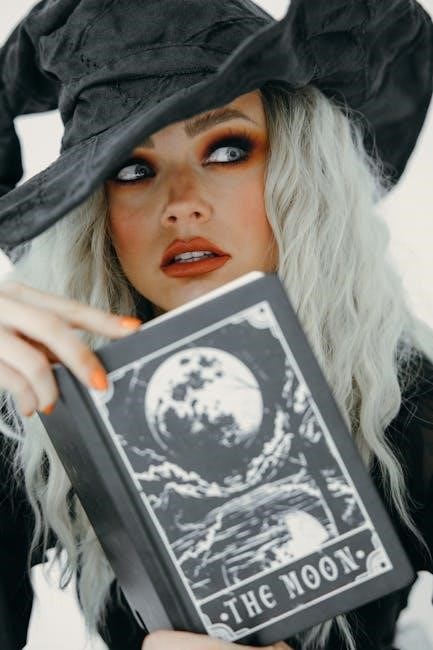witch guide
Modern witchcraft blends ancient traditions with contemporary practices, offering a diverse and inclusive path for spiritual growth. Wicca, a prominent modern practice, emphasizes harmony with nature and personal empowerment. This guide explores the fundamentals of witchcraft, providing a welcoming introduction for newcomers and deepening understanding for seasoned practitioners.
1.1 What is Modern Witchcraft?
Modern witchcraft is a dynamic and evolving spiritual practice that blends ancient traditions with contemporary beliefs. Rooted in Wicca and other pagan traditions, it emphasizes personal empowerment, harmony with nature, and the manipulation of energy for positive change. This modern interpretation encourages individuals to adapt practices to suit their lifestyles, fostering inclusivity and diversity. Witchcraft today is not confined to covens or rigid rituals; it is a deeply personal journey, allowing practitioners to explore magic, spirituality, and self-discovery. Whether through spellcasting, herbalism, or rune work, modern witchcraft offers a holistic approach to connecting with the universe and achieving balance in life. Its adaptability makes it accessible to anyone seeking meaning, growth, and transformation in the modern world.
1.2 The Evolution of Witchcraft in the Modern World
Modern witchcraft has evolved significantly, adapting to societal changes while preserving ancient traditions. The rise of the internet and social media has democratized access to witchcraft knowledge, allowing individuals to explore and practice independently. Today, witchcraft is more diverse, with practitioners blending various spiritual traditions, holistic practices, and personal beliefs. Popular culture, such as books and movies, has also played a role in normalizing and romanticizing witchcraft, leading to its widespread acceptance. This evolution reflects a broader societal shift toward seeking meaning, environmental consciousness, and personal empowerment. As a result, modern witchcraft is now a vibrant, inclusive, and ever-growing spiritual movement, embracing both tradition and innovation.

The Basics of Witchcraft
Witchcraft foundations include understanding spells, rituals, and the use of magical tools. Ethical practices and intention-setting are key, helping practitioners align their craft with personal and universal harmony.
2.1 Setting Up Your Witchcraft Altar
Creating a witchcraft altar is a sacred step in your practice, serving as a focal point for spells, rituals, and meditation. Choose a quiet, clean space, ideally facing north to symbolize stability and earth energy. Begin with a simple cloth or altar cloth, then add essential items like candles, crystals, and seasonal symbols. Include magical tools such as a wand, athame, or pentacle, each representing specific energies. Personalize your altar with meaningful objects like photographs, herbs, or deity statues. Keep the space organized and clutter-free to maintain clarity. Regularly cleanse and consecrate your altar to enhance its magical potency, ensuring it remains a powerful hub for your craft.
2.2 Essential Tools for Modern Witchcraft
Modern witchcraft relies on specific tools to enhance rituals and spellcasting. Begin with a wand, often made from wood or crystal, used to channel energy. An athame, a ritual dagger, symbolizes power and intention, while a pentacle represents earth and protection. Crystals and gemstones are versatile for healing and amplifying spells. Include candles in various colors to align with specific energies and intentions. A cauldron serves for mixing potions and symbolizing transformation. Keep a spell book or grimoire to record rituals and spells. Use a chalice for water or wine in ceremonies. These tools empower your practice, connecting you to your intent and the universe. They are not just objects but extensions of your will and magic.

Understanding Covens and Witchcraft Communities
Modern covens and witchcraft communities offer supportive groups for shared practices, fostering connection and magical collaboration. These networks empower individuals, encouraging personal growth and collective energy.
3.1 The Role of Covens in Modern Witchcraft
Covens play a vital role in modern witchcraft by providing a structured, supportive community for practitioners to learn and grow. They offer a space for shared rituals, spellcasting, and the exploration of magical practices. Covens often serve as educational hubs, teaching newcomers about ethics, traditions, and the craft. Members collaborate on spellwork, fostering a sense of unity and amplified magical energy. Additionally, covens provide emotional support and a sense of belonging, helping witches navigate their spiritual journeys. While solitary practice is valid, covens enrich the witchcraft experience through collective efforts and shared wisdom, making them a cornerstone of modern witchcraft communities.
3.2 Finding or Creating a Witchcraft Community
Finding or creating a witchcraft community can be a transformative experience, offering support, connection, and shared magical practice. Online forums, social media groups, and local meetups provide opportunities to connect with like-minded individuals. Modern witchcraft communities often embrace diversity, catering to various interests, such as herbalism, spellwork, or rune magic. For those in isolated areas, virtual covens and online workshops offer accessible alternatives. If no existing group resonates with your vision, consider creating your own community. Start small, focus on shared values, and foster an inclusive environment. Whether joining or leading, a witchcraft community enhances your journey, providing inspiration, guidance, and a sense of belonging in the modern witchcraft movement.

Spells and Rituals in Modern Witchcraft
Spells and rituals are core to modern witchcraft, focusing on intention, energy, and connection with nature. They empower individuals to manifest change, celebrate cycles, and honor the divine.
4.1 Basic Principles of Spellcasting
Spellcasting in modern witchcraft revolves around clear intention, focused energy, and visualization. Intention is the foundation, requiring a specific, positive goal. Energy is harnessed from personal willpower, nature, or tools like crystals and herbs. Visualization helps manifest the desired outcome, while focus ensures concentration. Timing, such as aligning with moon phases, enhances potency. Rituals often include casting a circle for protection and sacred space. Ethics are crucial; spells should not harm others or violate free will. Beginners are encouraged to start with simple practices, grounding and centering to balance energy. Patience and belief in the process are key, as results may unfold gradually. This approach fosters a deep connection with magic and personal growth.
4.2 Popular Types of Spells for Modern Witches
Modern witches often practice a variety of spells tailored to specific needs. Love spells focus on attracting or nurturing relationships, while prosperity spells aim to enhance financial stability and abundance. Protection spells are used to create safe, secure environments, warding off negative energy. Healing spells target physical, emotional, or spiritual well-being, often incorporating herbs and crystals. Moon magic aligns spellwork with lunar phases, amplifying intentions during the full moon for release or the new moon for new beginnings. These practices emphasize personal growth, ethics, and harmony with nature, making them accessible and meaningful for contemporary practitioners.

Herbal Magic in Witchcraft
Herbal magic is a cornerstone of witchcraft, utilizing plants for spells, rituals, and potions. Herbs like chamomile and sage enhance magic and promote emotional and physical well-being. Modern witches create herbal remedies to harness nature’s power for healing and protection.
5.1 The Use of Herbs in Spells and Rituals
Herbs are integral to spells and rituals, serving as powerful tools for manifestation and energy work. Dried or fresh plants like chamomile, sage, and lavender are often used to cleanse spaces, attract positivity, or protect against negativity. In rituals, herbs are burned, carried in sachets, or steeped in teas to align with specific intentions. For example, rose petals are commonly used in love spells, while mint is employed for prosperity and clarity. Modern witches also infuse herbs into potions, oils, and incense to enhance their magical properties. The choice of herb depends on its metaphysical attributes, making it essential to research and understand their meanings before use. This practice connects witches to nature and amplifies their spells’ effectiveness.
5.2 Creating Herbal Potions and Remedies
Herbal potions and remedies are a cornerstone of modern witchcraft, blending natural ingredients with magical intent. Witches often infuse herbs into oils, teas, or salves to harness their healing and mystical properties. The process begins with selecting high-quality, organic herbs, which are then dried or fresh, depending on the desired effect. Potions can be crafted by steeping herbs in water or alcohol, while remedies like salves require blending with carrier oils and beeswax. Many modern practitioners use these creations for healing, protection, or spiritual growth. Customizing potions with specific intentions and correspondences enhances their potency. This practice not only connects witches to nature but also empowers them to take charge of their well-being and magical practices. Research and safety are key to creating effective and safe herbal remedies.
